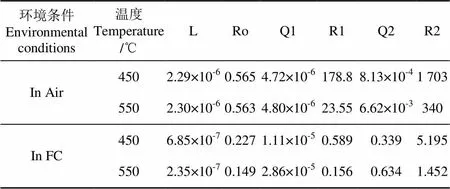具对称电极结构的中温固体氧化物电解池电解水制氢技术
2017-06-27陆玉正张耀明
陆玉正,王 军,蒋 川,杨 嵩,张耀明
具对称电极结构的中温固体氧化物电解池电解水制氢技术
陆玉正,王 军※,蒋 川,杨 嵩,张耀明
(东南大学能源与环境学院,江苏省太阳能技术重点试验室,南京 210018)
该文基于传统阳极-电解质-阴极结构的固体氧化物电解池,设计并研究了一种新型的具有对称电极结构的固体氧化物电解池。采用化学沉淀法制备了电解质材料Ce0.8Sm0.2O1.9-Na2CO3(NSDC)以及选择与之兼容性良好的电极材料Ni0.8Co0.15Al0.05LiO2-δ(NCAL)。该文利用X射线衍射法与环境扫描电子显微镜对制备的材料进行了性能表征和分析,分析结果表明合成的NSDC粉体材料也为萤石型结构,其粒子大小范围约为30~80 nm。基于制备的电解质材料和电极材料,进一步制备了具有对称电极结构的固体氧化物电解池的单电池。电化学试验结果表明:在电解池模式,单电池具有良好的制氢性能。互换电极后,仍表现出良好的电化学性能。理论分析和试验结果充分说明,该电解池具有良好的结构对称性。为中温固体氧化物电解制氢技术与太阳能光热、光电技术耦合研究提供参考。
电极;压力;氢;中温固体氧化物电解池
0 引 言
固体氧化物电解池(solid oxide electrolysis cell,SOEC)可以将电能和热能转化为化学能,可视为固体氧化物燃料电池(solid oxide fuel cell,SOFC)的逆过程。按操作温度大致可分为高温段(900~1 100 ℃)、中温段(600~850 ℃)和低温段(400~600 ℃)[1]。目前中国许多科研院所都在进行制氢的研究工作。毛宗强等在化石燃料制氢等方面取得了诸多的成果[1-2]。梁慧荣等对生物及有机废料的超临界水热化学制氢进行研究[3-4];Liu等对光催化分解水制氢方面进行了研究[5-6];范慧等[7-10]在可逆燃料电池-电解池材料及系统研究方面取得了巨大地突破;张文强等[11]将核能高温气冷堆与制氢技术相结合,完成了高温固体氧化物单电池制氢测试平台和关键材料的研究[12-14]及系统的热力学分析[15],其高温气冷试验堆(HTR-10)[11],被认为是最有希望用于制氢的核能系统。
Idaho工程、环境国家试验室和Ceramatec公司联合研制出由10个电池单片构成的电解池堆,产氢速率大于90 L/h[16]。2009年该研究团队进一步研制了3个电解池模块,稳定运行1 080 h,平均产氢率为1.2 m3/h[17]。丹麦RISO国家试验室联合欧洲能源研究所制备了固体氧化物电解池单体,当电解电压为1.48 V时,电解电流密度达到−3.6 A/cm2[18-19]。
从热力学角度,电解水消耗的能量由电能和热能两部分组成[20-21]。
从热力学的角度看,高温运行可以提高制氢效率并降低能量损失。但是温度过高,一方面,高温热源难以获得,另一方面,对电解池的材料以及密封材料提出很高的要求。因此适当的降低电解温度,对电解制氢的产业化是有利的。
基于以上综述,固体氧化物电解池制氢技术是制氢研究的重点方向之一。选择合适的材料、研究符合具有产业化前景的固体氧化物电解池越来越受到重视。本文从材料方面创新,研究一种新的电解质材料Ce0.8Sm0.2O1.9-Na2CO3(NSDC,钐掺杂氧化铈-碳酸盐复合材料),基于新研制的电解质材料,进一步研制出一种新型的对称电极结构的固体氧化物电解池,该电解池可以运行在550 ℃左右。根据该电解池的温度运行特性,研究了太阳能与电解池联合制氢系统,制氢过程所需要的热能和电能均有太阳能提供。将中温固体氧化物电解制氢技术与太阳能光热、光电技术耦合,可以开拓太阳能新的应用领域。
1 太阳能中温电解水蒸气制氢系统
中温固体氧化物电解池所需要的电能和热能可以由太阳能提供,从而实现太阳能高效电解制氢。系统主要由固体氧化物电解池、碟式太阳能热利用装置、光伏发电装置和换热系统构成,如图1所示。
solar为系统接收到的太阳能辐射总功率,kW,可分为dish和pv,可表示为:
solar=pv+dish(2)
dish·η=heat,SOEC+heat,H2O(3)
pv·η=electricity(4)
式中η为碟式太阳能光热转换效率,与聚光器、接收器、传热特性等相关[7]。η为光伏电池的光电转换效率,与光伏电池的材料和制备工艺等相关[22]。electricity为太阳能经过光伏电池转换后获得的电能,给SOEC所需要的电能,kW。dish将太阳能转换为热能后分为heat,SOEC、heat,H2O分别给SOEC和换热器Ⅱ提供热源。光伏发电系统的直流电能经过太阳能控制器转换后,给SOEC提供电解所需要的电能,实现了太阳能高效制氢。其中,SOEC是该系统的关键技术。
2 对称电极结构SOEC
2.1 对称电极结构SOEC基本原理
对称电极结构的固体氧化物电解池结构与对称电极结构的固体氧化物燃料电池结构完全一致,只是运行状态相反,如图2所示。化学反应过程为:
氢气极:
2H2O+4e→2H2+2O2-(5)
空气极:
2O2--4e→O2(6)
总反应:
2H2O→2H2+O2(7)
由图2可知,该化学反应过程与氧离子型固体氧化物电解池(O-SOEC)的化学反应相同,但对称电极结构的SOEC与O-SOEC的区别在于阴极与阳极呈现对称结构,即阴极与阳极的材料相同、制作工艺相同且在电解质两侧呈现对称形式。
与传统阴极-电解质-阳极结构的SOEC相比,采用对称电极结构的SOEC具有以下几个明显的优点:
1)减轻了研究工作的任务,传统SOEC或SOFC需要研究阳极、阴极的材料性能以及阳极、阴极与电解质的匹配问题;
2)简化了电池制作工艺,只需考虑一个电极的制作以及与电解质的工艺匹配问题;
3)对称电极结构在实际应用过程中更加方便,无需区分阳极和阴极,不影响电池的性能。
此外,以纳米复合材料为主体的对称电极结构SOEC的运行温度一般在400~700 ℃之间,与传统的SOEC操作温度(800~1 000 ℃)相比,低温运行更有利于降低系统成本和推进商业化。
2.2 对称电极结构SOEC单电池制作
对称电极结构SOEC单电池的材料包括电解质材料和电极材料两部分。制备电解质的方法主要有直接法和沉淀法。直接法是指先将所需原材料(硝酸铈、硝酸钐等)按照一定比例直接混合,研磨后,放入箱式电阻炉内进行烧结,炉冷或空冷后就得到了所需的电解质。直接法制备过程中,硝酸盐不易分解且产生NOX等有毒气体。本文采用沉淀法制作电解质,即将硝酸盐原材料使用碳酸钠沉淀为碳酸盐,再使用箱式电阻炉进行烧结进而得到所需的电解质。本文制备电解质材料Ce0.8Sm0.2O1.9-Na2CO3(NSDC,钐掺杂氧化铈-碳酸盐复合材料)的流程图如图3所示。电极材料(阴极、阳极)均选用Ni0.8Co0.15Al0.05LiO2-δ(NCAL,镍钴铝锂)。
采用冷压方法制备对称电极结构的SOEC,具体制备工艺步骤如下:
1)将NCAL均匀地喷涂在泡沫镍的表面;将NCAL粉末材料溶于松油醇与乙醇混合溶液中(松油醇∶乙醇= 1∶1),喷涂后,放入干燥箱干燥30 min,再次喷涂,再烘干,直到泡沫镍表面呈现均匀的黑色。
2)将表面喷涂NCAL的泡沫镍剪切成电解池的磨具尺寸:直径=13 mm。
3)将剪切好的表面喷涂NCAL的泡沫镍放入电解池磨具中,铺上一层0.35 g NSDC粉体材料,压实。
4)在压实的NSDC粉体材料的上面放入表面喷涂NCAL的泡沫镍,再压实。
5)在10 MPa的压力下,保压10 s后,撤销压力,取出电池片。
形成致密且机械强度良好的电解池样品,样品尺寸为直径=13 mm,厚度=1 mm的纽扣型单电池片,实际有效反应面积为0.64 cm2。
3 表征及试验
本文采用XRD对材料的物相结构进行表征和采用SEM进行固体、粉末、品微观形貌观测。
3.1 表 征
X射线衍射法(X-ray diffraction,XRD)是目前分析和研究粉体材料最常用的一种方法。根据测试图片中特征峰的位置可以判断物质的物相。理论上来说,任何结晶物质都具有特定的晶体结构和相对应的结构参数。因此当X射线入射时,物质会产生特定的X射线衍射峰。不同物质的衍射谱图都不相同。根据X射线衍射谱图的特点,可以对物质结构进行分析。包括材料本身内部的晶胞参数,元素位置以及粒径大小等信息[23]。
本文使用的X射线衍射仪型号为Philips X’pert PROS diffractometer。XRD谱图扫描范围为10°到80°,扫描速度为8°/min。图4给出了NSDC和NCAL两种粉体材料在高温烧结后冷却到常温条件下的XRD衍射图谱。所有的NSDC衍射峰与SDC(Ce0.8Sm0.2O1.9,PDF No. 75-0158)衍射峰对应。没有发现Na2CO3相,表明二氧化铈-碳酸盐(ceria-carbonates)是两相材料,碳酸盐是一种非晶态。NCAL(Ni0.8Co0.2Li-oxide,PDF No. 87-1562)的XRD衍射图谱中没有发现Al,这是由于Al的含量过低的缘故。一般的,氧化铈(CeO2)具有萤石型结构。本文制备的NSDC粉体材料的XRD衍射图谱中的衍射峰与标准氧化铈卡片的峰值对应一致,没有新相出现。该结果表明合成的NSDC粉体材料也为萤石型结构[24-26]。
微观结构表征可采用环境扫描电子显微镜(scanning electron microscope,SEM)进行表征。图5描述了NSDC和NCAL 2种粉体材料的SEM微观结构图。由图可知,NCAL材料晶粒尺寸较大,约为几微米至几十微米。NSDC粉体材料表现出一定的团聚现象,主要是由于高温烧结工艺的缘故,其粒子大小范围约为30~80 nm。
电化学阻抗分析(electrochemical impedance spectroscopy,EIS)是通过测量阻抗随正弦波频率的变化,进而分析电极过程动力学、双电层和扩散等,研究电极材料、固体电解质、导电高分子以及腐蚀防护等机理,是研究电化学反应过程的重要方法[27]。本论文测试的阻抗特性如图6所示,图6a,b分别表示电池在空气气氛下和燃料电池环境下的阻抗特性,测试温度分别为450 ℃(≈723 K)和550 ℃(≈823 K)。为了描述电池的内阻,通过ZSimpWin软件模拟电池的等效电路结构为LRo (R1Q1)(R2Q2),如图6c所示。等效电路拟合的阻抗结果如表1所示。等效电路中,表示测试系统中不锈钢管产生的自感,Ro表示电解质的欧姆电阻。R1Q1和R2Q2分别表示电荷转移和质量转移过程。在空气气氛下,EIS曲线表现出一个半圆形状。一般地,在高频区,半圆与材料的晶界有关,在低频区,与电极有关。在氢氧气氛下(燃料电池环境下),欧姆损失和界面电阻随着温度升高而降低,EIS曲线出现明显的变形。与空气气氛环境相比,在氢氧气氛下总的电阻明显减小。

表1 用LRo(R1Q1)(R2Q2)模拟电路模拟阻抗结果
3.2 试验与结果分析
水供给流量设定为0.25 mL/min,加热炉的温度分别设定为=723 K(≈450 ℃)、=823 K(≈550 ℃)、=923 K(≈650 ℃)进行试验。电解电流随电压变化的曲线如图7所示。试验测得电池在电解模式的开路电压分别为1.086、0.975、0.899 V,测试开路电压接近理论开路电压值。电解电压达到1.5 V时,=723、823、923 K时,所对应的电解电流密度为0.177、0.376、0.544 A/cm2。
固体氧化物电解制氢技术,其氢气产生速率与电解电流密度相关[28-29],根据库伦定律:

对称电极结构的固体氧化物电解池操作温度适中,热源可以从新能源中得到,例如聚光太阳能等。电解需要的电能随着温度的升高而降低,在100 ℃时,电能在整个电解过程所需能量中的比例约为93%,当操作温度升高到550 ℃时约为83%,而温度升高到1 000 ℃时只有约72%。随着电能的降低,水的理论分解电压也随温度的升高而降低,即中、高温下(600~1 000 ℃)电解水可以降低制氢过程中电能的消耗,增加热能的比例。
4 结 论
本文提出的对称电极结构的中温固体氧化物电解池,具有电解电动势低,电解效率高,本文的初步研究可以得出以下结论:
1)水供给流量为0.25 mL/min,加热炉的温度分别为=723 K(≈450 ℃)、=823 K(≈550 ℃)、=923 K(≈650 ℃)时,试验测得电池在电解模式的开路电压分别为1.086、0.975、0.899 V,测试开路电压接近理论开路电压值。电解电压达到1.5 V时,=723、823、923 K时,所对应的电解电流密度为0.177、0.376、0.544 A/cm2。
2)对称电极结构的固体氧化物电解池的操作温度不宜过高,当温度超过923 K时,性能衰减快,试验过程中每小时的衰减率达到2%。
对称电极结构的固体氧化物电解池电解水蒸气制氢可以与不稳定新能源发电技术结合,如太阳能光伏发电和风电,将不稳定的新能源转换为氢能储存。
[1] 毛宗强. 低温固体氧化物燃料电池[M]. 北京:上海科学技术出版社,2013:21-42.
[2] Huang J, Mao Z, Liu Z, et a1. Performance of fuel cells with proton-conducting ceria-based composite electrolyte and nickel-based electrode[J]. Journal of Power Sources, 2008, 175: 238-243.
[3] 梁慧荣,张耀君,郭烈锦. N掺杂Ta2O5的制备及其光催化分解水制氢性能研究[J]. 太阳能学报,2006,27(10):1032.
Liang Huirong, Zhang Yaojun, Guo Liejin. Fabrication of N-doped Ta2O5catalysis and its performance for photocatalytic production of hydreogen[J]. Acta Energiae Solaris Sinica, 2006, 27(10): 1032. (in Chinese with English abstract)
[4] 师进文,郭烈锦. Cr或V掺杂的HMS在甲酸溶液中的光催化产氢性能研究[J]. 化学学报,2007,65(4):323.
Shi Jinwen, Guo Liejin. Photocatalytic Performance of HMS doped with chromium or vanadium for hydrogen production in aqueous formic acid solution[J]. Acta Chimica Sinica, 2007, 65(4): 323. (in Chinese with English abstract)
[5] Liu Qinggang, Yang Xiaofeng, Huang, Yanqiang, et al. A Schiff base modified gold catalyst for green and efficient H2production from formic acid[J]. Energy & Environmental Science, 2015, 8(11): 3204-3207.
[6] Zhou Jinxia, Xia Zhi, Huang Tingyu, et al. An ionic liquid-organics-water ternary biphasic system enhances the 5-hydroxymethylfurfural yield in catalytic conversion of glucose at high concentrations[J]. Green Chemistry, 2015, 17(8): 4206-4216.
[7] 范慧,宋世栋,韩敏芳. 固体氧化物电解池共电解H2O/CO2研究进展[J]. 中国工程科学,2013,15(2):107-112.
Fan Hui, Song Shidong, Han Minfang. Development of H2O/CO2co-electrolysis in solid oxide electrolysis cell [J]. Engineering Science, 2013, 15(2): 107-112. (in Chinese with English abstract)
[8] Han Minfang, Fan Hui, Peng Suping. H2O/CO2co-electrolysis in solid oxide electrolysis cells[J]. Engineering Science, 2014, 12(1): 43-50.
[9] Song Shidong, Han Minfang, Zhan Jianqiang. NiCu-Zr0.1Ce0.9O2-δanode materials for intermediate temperature solid oxide fuel cells using hydrocarbon fuels[J]. Journal of Power Sources, 2013, 233: 62-68.
[10] Hui Fan, Michael Keane, Prabhakar Sing, et al. Electrochemical performance and stability of lanthanum strontium cobalt ferrite oxygen electrode with gadolinia doped ceria barrier layer for reversible solid oxide fuel cell[J]. Journal of Power Sources, 2014, 26: 634-639.
[11] 张文强,于波,陈靖,等. 高温固体氧化物电解水制氢技术[J]. 化学进展,2008,20(5):778-792.
Zhang Wenqiang, Yu Bo, Chen Jing, et al. Hydrogen production through solid oxide electrolysis at elevated temperatures[J]. Progress in Chemistry, 2008, 20(5): 778-792. (in Chinese with English abstract)
[12] Yu B, Zhang W Q, Xu J M, et al. Microstructural characterization and electrochemical properties of Ba0.5Sr0.5Co0.8Fe0.2O3–δand its application for anode of SOEC[J]. International Journal of Hydrogen Energy, 2008, 33: 6873-6877.
[13] Liang M D, Yu B, Wen M F, et al. Preparation of LSM-YSZ composite powder for anode of solid oxide electrolysis cell and its activation mechanism[J]. Journal of Power Sources, 2009, 90: 341-345.
[14] Kong J R, Zhang Y, Deng C S, et al. Synthesis and electrochemical properties of LSM and LSF perovskites as anode materials for high temperature steam electrolysis[J]. Journal of Power Sources, 2009, 186: 485-489.
[15] Liu M Y, Yu B, Xu J M, et al. Thermodynamic analysis of the efficiency of high-temperature steam electrolysis system for hydrogen production[J]. Journal of Power Sources, 2008, 177: 493-499.
[16] O’brien J E, Stoots C M, Herring J S, et al. Hydrogen produc- tion performance of a 10-cell planar solid-oxide electrolysis stack[J]. Journal of Fuel Cell Science and Technology, 2006, 3: 213-219.
[17] Stoots C M, O’brien J E, Condie K G, et al. High-temperature electrolysis for large-scale hydrogen production from nuclear energy-Experimental investigations[J]. International Journal of Hydrogen Energy, 2010, 35: 4861-4870.
[18] Doenitz W, Dietrich G, Erdle E, et al. Electrochemical high temperature technology for hydrogen production or direct electicity generation[J]. International Journal of Hydrogen Energy, 1988, 13: 283-287.
[19] Hauch A. Solid Oxide Electrolysis Cells-Performance and Durability[D]. Denmark: Risø National Laboratory, Technical University of Denmark, 2007.
[20] Liu Mingyi, Yu Bo, Xu Jingming, et al. Thermodynamic analysis of the efficiency of high-temperature steam electrolysis system for hydrogen production[J]. Journal of Power Sources, 2008, 177: 493-499.
[21] Meng N, Leung M K H, Leung D Y C. A modeling study on concentration over potentials of a reversible solid oxide fuel cell[J]. Journal of Power Sources, 2006, 163: 460-466.
[22] Chow T T, Tiwari G N, et al. Hybrid solar: A review on photovoltaic and thermal power integration[J]. International Journal of Photoenergy, 2012, 10: 1155-1172.
[23] 胡慧庆. 单部件燃料电池的性能研究[D]. 合肥:中国科学技术大学,2015.
Hu Huiqing. Performance Study for Single Layer Fuel Cell[D]. Hefei:University of Science and Technology of China, 2015. (in Chinese with English abstract)
[24] Palard M, Balencie J, Maguer A, et al. Effect of hydrothermal ripening on the photoluminescence properties of pure and doped cerium oxide nanoparticles[J]. Materials Chemistry and Physics, 2010, 120: 79-88.
[25] Reddy B M, Bharali P. Catalytic efficiency of ceria-zirconia and ceria-hafnia nanocomposite oxide for soot oxidation[J]. Catalysis Letters, 2008, 123: 327-333.
[26] Eguchi K, Kunishaki T, Arai H. Effect of microsctructures on the lonic conductivity of ceria-calcia oxides[J]. Journal of American Ceramic Society, 1986, 69: 282-285.
[27] Fan L D, Zhang H J, Chen M M, et al. Electrochemical study of lithiated transition metal oxide composite as symmetrical electrode for low temperature ceramic fuel cells[J]. International Journal of Hydrogen Energy, 2013, 38: 11398-11405.
[28] 范慧. 可逆燃料电池-电解池氧电极复合改性研究[D]. 北京:中国矿业大学,2014.
Fan Hui. Study on Combined Modification of Oxygen Electrode for Reversible Solid Oxide Fuel Cell-electrolysis Cell[D]. Beijing: China University of Mining and Technology, 2014. (in Chinese with English abstract)
[29] Sune Dalgaard Ebbesen, Mogens Mogensen. Electrolysis of carbon dioxide in Solid Oxide Electrolysis Cells[J]. Journal of Power Sources, 2009, 193: 349-358.
[30] Choi M B, Singh B, Wachsman E D, et al. Performance of La0.1Sr0.9Co0.8Fe0.2O3-δand La0.1Sr0.9Co0.8Fe0.2O3-δ-Ce0.9Gd0.1O2oxygen electrodes with Ce0.9Gd0.1O2barrier layer in reversible solid oxide fule cells[J]. Journal of Power Sources, 2013, 239: 361-373.
Hydrogen production technology by solid oxide electrolysis cell with symmetrical eletrode at intermediate temperature
Lu Yuzheng, Wang Jun※, Jiang Chuan, Yang Song, Zhang Yaoming
(210018)
Efficient, clean and sustainable energy become the focus of current energy research. Although solar power, wind power and tidal power are promising renewable energy sources, they are site-specific and intermittent, which is not suitable for continuous energy supply. Hydrogen, which is transportable and storable, could serve as an attractive option for energy carrier. Nowadays, it is important to develop a technology for producing hydrogen with high efficiency and low pollution. Solid oxide electrolysis cells (SOEC) based on solid oxide fuel cell (SOFC) technology provides a solution in which hydrogen is produced from water and oxygen is the only by-product. Hybrid hydrogen production integrating solar energy and solid oxide electrolysis cell (SOEC) is an energy conversion device with high performances. In this paper, a hydrogen production system was designed based on intermediate temperature solid oxide electrolysis cell. Solar energy was utilized as the only prime energy sources for the system. The demands of thermal energy and electricity for the hydrogen production were supplied by solar dish and photovoltaic subsystem, respectively and SOEC was the key component of the hybrid system. A new type of solid oxide electrolysis cell, having the symmetrical electrode structure, was proposed and studied in this paper, which was based on the solid oxide electrolysis cell with the conventional structure of anode-electrolyte-cathode. The chemical precipitation method was used to produce the electrolyte material, Ce0.8Sm0.2O1.9-Na2CO3(NSDC), and to find out the specific electrode material compatible well with the NSDC, the Ni0.8Co0.15Al0.05LiO2-δ(NCAL). X-ray diffraction (XRD) method and scanning electron microscope (SEM) were utilized in this paper for the description as well as the analysis of performance relating to the materials produced. The results showed that the NSDC also has a fluorite structure, the particle size of which was in the range from 30 to 80 nm. Further, the solid oxide electrolysis cell was fabricated though using the NSDC and NCAL obtained earlier. Under SOEC mode and current density of 0.376 A/cm2, the electrolyte voltage was 1.5 V at 823 K.The results of electrochemical experiments showed that a good performance of hydrogen production can be achieved by using the single cell in the electrolysis mode. Moreover, the electrochemical performance still remained in a good condition even the electrodes were switched. According to the theoretical analysis and the experimental results, it can be demonstrated that this new type of cell shows a good structural symmetry. In addition, intermediate-temperature system can promote electrode activity and lessen the over potential. Therefore, it is possible to increase the electric current density and consequently decrease the polarization losses at intermediate temperature, which improves the hydrogen production density and the electrolysis efficiency. Thus, this new hybrid hydrogen production system is advantages from both thermodynamic and kinetic standpoints. The hybrid hydrogen production integrating solar energy operation at intermediate temperature is much more efficient than low-temperature water electrolysis systems such as alkaline water electrolysis and solid polymer electrolyte water electrolysis. The obstacle for the development of SOEC technology is the cost. Fortunately, the cost of this new structure of SOEC with the symmetrical electrode is very low. It is our hope that the results we report here may pave a way for SOEC industrialization.
electrodes; pressure; hydrogen; intermediate temperature solid oxide electrolysis cells
10.11975/j.issn.1002-6819.2017.09.031
TK91
A
1002-6819(2017)-09-0237-06
2016-10-22
2017-03-10
江苏省科技支撑计划项目(BE2013121)
陆玉正,男(汉族),安徽庐江人,博士生,主要从事新能源技术研究。南京 东南大学能源与环境学院,210018。Email:mrluyuzheng@163.com
王军,男(汉族),江苏盐城人,博士,主要从事太阳能利用研究。南京 东南大学能源与环境学院,210018。Email:wj-jw@seu.edu.cn
陆玉正,王 军,蒋 川,杨 嵩,张耀明. 具对称电极结构的中温固体氧化物电解池电解水制氢技术[J]. 农业工程学报,2017,33(9):237-242. doi:10.11975/j.issn.1002-6819.2017.09.031 http://www.tcsae.org
Lu Yuzheng, Wang Jun, Jiang Chuan, Yang Song, Zhang Yaoming. Hydrogen production technology by solid oxide electrolysis cell with symmetrical eletrode at intermediate temperature[J]. Transactions of the Chinese Society of Agricultural Engineering (Transactions of the CSAE), 2017, 33(9): 237-242. (in Chinese with English abstract) doi:10.11975/j.issn.1002-6819.2017.09.031 http://www.tcsae.org
